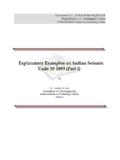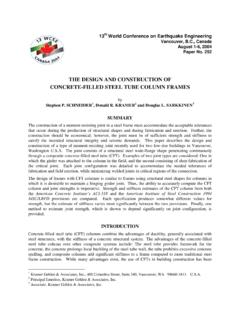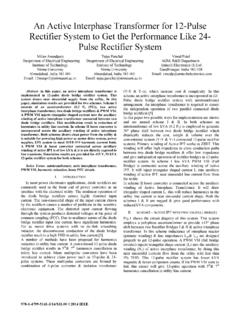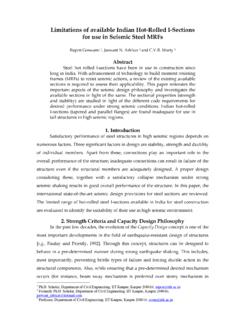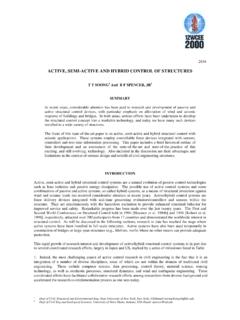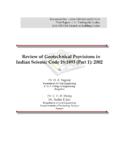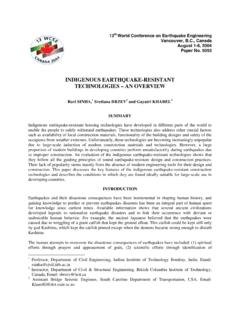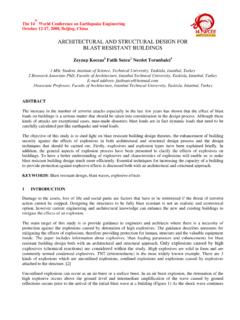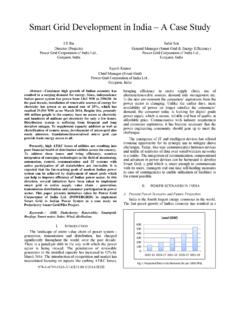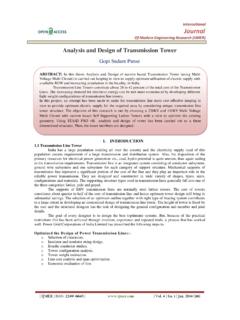Transcription of EFFECTS OF DIFFERENT BACKFILL SOIL TYPES ON …
1 The 14th World Conference on Earthquake Engineering October 12-17, 2008, Beijing, China EFFECTS OF DIFFERENT BACKFILL SOIL TYPES ON DYNAMIC BEHAVIOR OF RECTANGULAR TANK WALL CONSIDERING BACKFILL -WALL-FLUID INTERACTION T. AKIR1 R. L VA O LU2 A. DO ANG N3 1 Research Assistant, Department of Civil Engineering, G m hane University, G m hane, T rkiye 2 Assistant Professor, Department of Civil Engineering, G m hane University, G m hane, T rkiye 3 Professor, Department of Civil Engineering, Karadeniz Technical University, Trabzon, T rkiye Email: ABSTRACT This study focused on the EFFECTS of BACKFILL soil TYPES variation on seismic response of rectangular storage tanks. However, only the exterior wall of the rectangular tank interacts with both BACKFILL and fluid is tackled since each part of the structure shows considerable differences in terms of the loads subjected to along with geometrical and positional differences.
2 Hence, the objectives of this study are to develop a model to determine the response of tank wall under dynamic loading and to examine the commonly encountered BACKFILL EFFECTS on dynamic response of rectangular tank wall. Three DIFFERENT BACKFILL soil TYPES , which are classified by Unified Soil Classification System, were chosen to represent the soil properties in the analyses. These are poorly graded gravels (GP), silty gravels (GM) and poorly graded sands (SP). Drucker-Prager material approach is used for elasto-plastic soil behavior, and also nonlinear wall-soil interface behavior including seperation is considered. Fluid-rectangular tank wall- BACKFILL system is modeled with the finite element method considering wall- BACKFILL interaction. In addition to this, the fluid-wall interaction is taken into account using Lagrangian approach. The findings obtained from the study showed that maximum vertical displacements of BACKFILL , lateral and roof displacements, stress responses generally decreased with increasing BACKFILL soil stiffness.
3 However, sloshing displacement is not affected by BACKFILL -wall interaction. KEYWORDS: rectangular tank, wall- BACKFILL interaction, fluid-structure interaction 1. INTRODUCTION Liquid storage tanks are becoming more and more prevalent in the modern world due to fast growing population and industry. As an integral part of the infrastructure of modern society, these structures are used for a wide range of goals, to store water for drinking and fire fighting, chemicals, petroleum, and liquefied gas, etc. Therefore, the liquid storage tanks should remain functional in the post-earthquake period to ensure water supply in earthquake-affected regions. In some cases, however, these structures have collapsed during earthquakes with disastrous physical and economical consequences. Thus, to ensure the safety of liquid storage tanks, the seismic behavior of them has been studied for many years.
4 Depending on design conditions and load bearing mechanisms, the tanks are classified into DIFFERENT categories, rectangular tanks, elevated tanks, underground tanks, ground-level cylindrical tanks, etc. Numerous studies have been carried out for seismic behavior of liquid storage tanks, however, most of these studies have concentrated on the ground-level cylindrical tanks. The effect of soil pressure is important in a number of problems, such as retaining and sheet pile walls, basement walls, bridge abutments, tunnel walls and many other structures. Earthquakes have unfavorable EFFECTS on lateral soil pressures acting on retaining walls. Hence, the assessment of seismic lateral soil pressures is of practical significance in most seismic designs of retaining walls. Discussion of the all the research work on the seismic soil pressure is extensive and is beyond the scope of this study. Rather, only some milestones that have influenced the design practice are described below.
5 The pioneering work, currently known as the Mononobe-The 14th World Conference on Earthquake Engineering October 12-17, 2008, Beijing, China Okabe method (M-O), is developed by Okabe (1924) and Mononobe and Matsuo (1929). Since then, a great deal of research has been performed to evaluate its adequacy and to improve it. Nazarian and Hadjian (1979) reported on a survey of the literature in the area of earthquake-induced lateral soil pressures and identified the shortcomings of DIFFERENT approaches. Seed and Whitman (1970) focused on limit-state design and they used modified Mononobe Okabe analysis, an extension of the Coulomb-Rankine sliding wedge theory. Also, a detailed summary of retaining wall damage during earthquakes was reported by Seed and Whitman (1970). The pseudo-static design and the plastic equilibrium mechanisms are adopted in these methods.
6 However, displacements of the retaining walls may be induced during earthquakes. Therefore, a displacement-based design needs to be introduced. Thus, Richards and Elms (1979) proposed a procedure to design retaining walls taking into account the permissible displacements of the wall. Some researches focused on elastic or elasto-plastic approximations, elastic solutions have been developed like Wood s solution which for a rigid wall fixed at its base lead to pseudo-static earth pressures hereby times higher than Mononobe-Okabe (Gazetas et al., 2004). Furthermore, Veletsos and Younan (1994a, 1994b) developed a simple approximate expression for simulating the dynamic pressures, the associate forces, and the responses induced by ground shaking on a straight, vertical rigid wall retaining soil with a semi-infinite, uniform viscoelastic layer of constant thickness.
7 The solutions for frequency-dependent and frequency-independent parameters were studied and compared with the results proposed by Scott (1973). The elastic constrained bars with distributed mass were used to represent the soil stratum in BACKFILL . They concluded that Scott s (1973) model, which ignores radiational soil damping and considers the wall pressure to be proportional to the relative motions of the wall and the soil at the far field, does not adequately describe the action of the system and may lead to large errors. From the above discussion, it can be stated that there is no literature about the analysis of BACKFILL -rectangular drinking water storage tank wall- fluid system under the combined actions of forces induced by fluid and soil interactions. Literature investigations also show that relatively little work has been done on rectangular storage tanks. Moreover, DIFFERENT studies are extremely essential for the design purpose of the rectangular drinking water storage tanks.
8 Therefore, the aims of this study are to appreciate the significance of the BACKFILL EFFECTS and investigate how DIFFERENT BACKFILL soil TYPES affect the seismic behavior of rectangular tank wall. In order to achieve the objectives of this study, finite element analyses covering BACKFILL -tank wall-fluid system have been performed considering both soil and fluid interactions. 2. DESCRIPTION OF THE CONSIDERED RECTANGULAR TANK SYSTEM In this study, the structural properties of the prismatic reinforced concrete rectangular storage tank with a container capacity of 10000 m3, which is frequently constructed in Turkey, were considered as shown in Fig. 1. For that purpose, K k o lu drinking water tank constructed in Samsun province in Turkey was selected as the reference structure. Considered rectangular tank has two main divisions. The length and the width of the structure are 61 m and m, respectively.
9 Total height of the reference tank is m from the bottom of the foundation. The other characteristics like dimensions of the tank and the foundation system are shown in In the analyses, Young s Modulus, Poisson s ratio and the weight of concrete per unit volume are taken to be 28000 MPa and and 25kN/m3, respectively. The container is filled of water with a density of 1000 kg/m3. In such structures, the maximum service level (liquid level) is taken into account as m. The exterior wall of the rectangular tank considered in this study interacts with various soil TYPES encountered in practice. Many TYPES of material can be used for BACKFILL . Clean sands and gravels are the most suitable materials. They drain rapidly, are not susceptible to frost action, and remain stable. Silty sands, silts and coarse-grained soils containing some clay are less desirable since they drain slowly, are subjected to seasonal volume changes, and may lose much of their strength with time.
10 But frequently in practice, the excavated soil materials are used as BACKFILL . In the light of these explanations, dry-cohesionless poorly graded gravels (GP), silty gravels (GM) and poorly graded sands (SP) were taken into consideration as BACKFILL materials. The soil properties used in the analyses are shown in Table 1. The 14th World Conference on Earthquake Engineering October 12-17, 2008, Beijing, China Figure 1 Considered tank and the exterior wall properties Table 1 Data for considered BACKFILL soil TYPES Name of the model BF35_SP BF33_GM BF34_GP Soil Properties 35 33 34 E (MPa) 20 75 125 (kN/m3) 19 22 E :Young Modulus ; : Internal friction angle ; : Poisson ratio ; : unit weight of soil 3.
